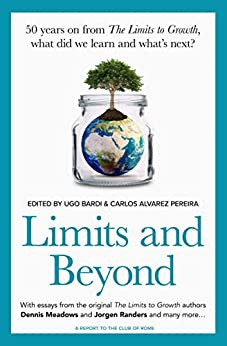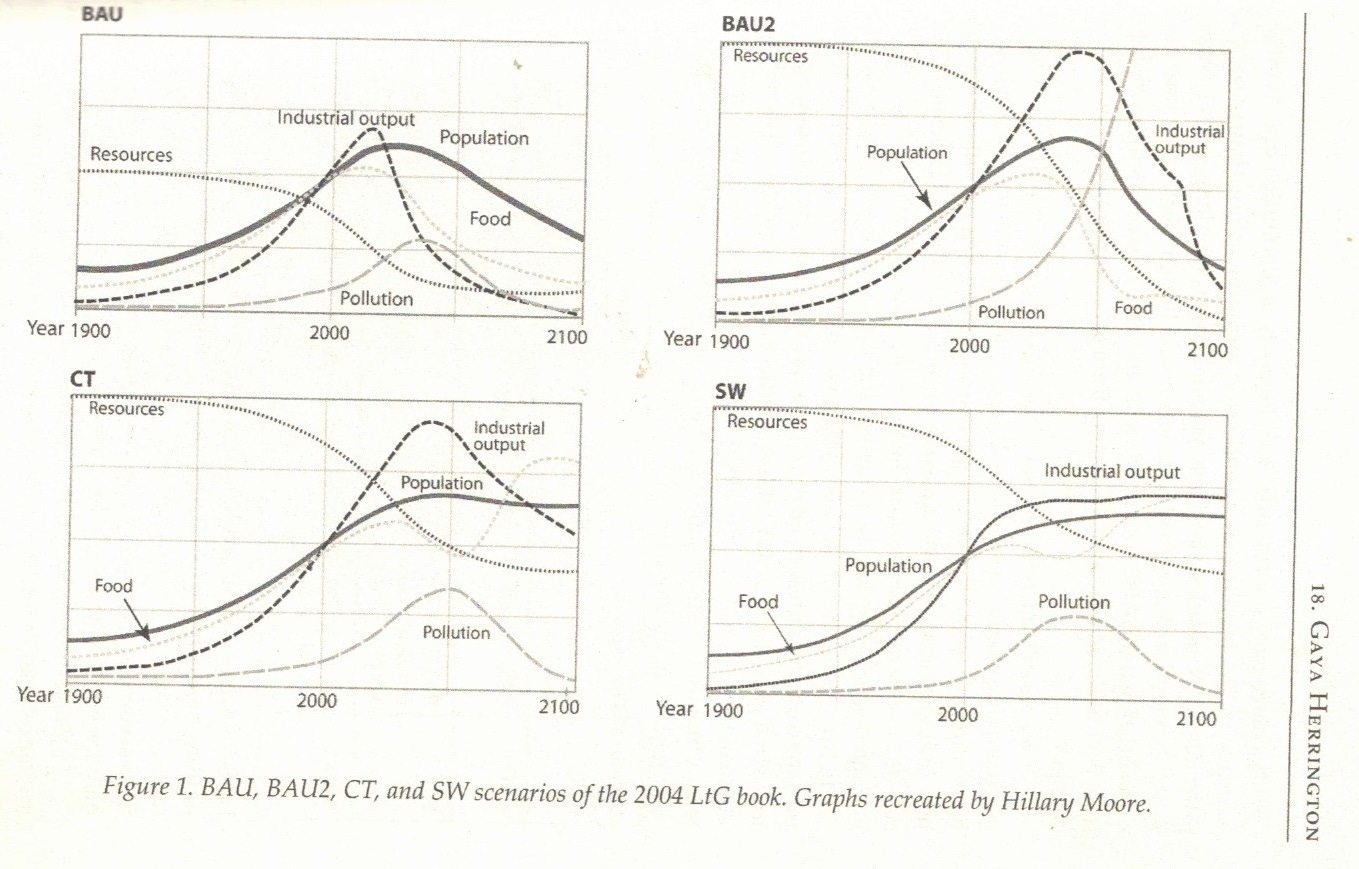
I have been posting a series of review of the recent report to the Club of Rome "Limits and Beyond." Here is a recent post by Ian Sutton on his blog, "Netzero205." Many people still think that the original work of 1972, "The Limits to Growth" was "wrong." They'll have to change their minds, sooner or later. Here is a comment on how Gaya Herrington examined how the base case scenario of the 1972 book fared in 50 years. Judge by yourself!
Chapter 18: Better Windmills
The book Limits and Beyond, edited by Ugo Bardi and Carlos Alvarez Pereira, provides a 50th anniversary review of the seminal report Limits to Growth (LtG). The following is from the back cover of the book.
50 years ago the Club of Rome commissioned a report: Limits to Growth. They told us that, on our current path, we are heading for collapse in the first half of the 21st century. This book, published in the year 2022, reviews what has happened in the intervening time period. It asks three basic questions:
Were their models right?
Why was there such a backlash?
What did the world do about it?
The book consists of 19 chapters, each written by a different author, two of whom — Dennis Meadows and Jorgen Randers — were part of the team that wrote the report.
This post is the seventh in a series that reviews chapters of the book Limits and Beyond. We look at Chapter 18: I did a data check on World3 - Here’s what I found. (Previous reviews are summarized here.)
Four Scenarios
The author of Chapter 18, Gaya Herrington, compares four scenarios from the 2004 edition of Limits to Growth with empirical data. The scenarios are:
Business as Usual (BAU).
Business as Usual 2 (BAU2). This is BAU with double the natural resources.
Comprehensive Technology (CT).
Stabilized World (SW).
She summarizes her analysis in the following four charts.
A typical example of the comparison of the LTG scenarios and Herrington's data on the real world is shown below. The complete set can be found in her thesis.
I was reminded of Ms. Herrington’s work by a short conversation with a fellow church member this week. This person understood that the climate is changing (who could not given the events of recent days). He maintained that technology — in the form of windmills — could help save us. But he also realized that windmills have their limitations. For example, they are big and ugly. So, he asked, “Why don’t they make windmills with smaller blades?” In other words, this person accepted the ‘Comprehensive Technology’ approach. (I was restrained enough not to ask that person not look out of the window where he would have seen that the wind was not blowing.)
Currently, we are on the first track: Business as Usual track (BAU). In other words, in spite of the seemingly endless number of reports warning us of our predicament, society has not acted.
Since LtG was published additional resources, such as tight oil, have been made available, and technology has advanced. So BAU2 and CT need to be evaluated since they may represent our future direction.
Regarding BAU2, Herrington says,
More abundant resources do not avoid collapse in World3 scenarios; its cause merely changes from a resource scarcity crisis to a pollution one . . . BAU2 essentially tells the story of ecosystem breakdown from accumulated pollutions, including greenhouse gases.
With respect to CT she says,
It assumes unprecedented technological innovation in a world that does not otherwise does not change priorities much. The new technologies do in fact help avoid an outright collapse. However, CT sill results in some declines because technology costs become so high that not enough resources are left for agricultural production, health, and education.
She does, however, point out that many of the assumptions that lie behind CT are highly optimistic, and are not validated by empirical data.
Humanity can innovate itself out of one limit, like to some extent it has with resource constraint. But in a system like our global society, creating a solution to one limit inevitably causes interactions with other parts of the system, sooner or later giving rise to a new limit which then becomes the new binding constraint on growth. This new constraint today is pollution from greenhouses gases.
The conclusion is straightforward. We should drive toward the Stabilized World (SW) scenario. Doing so will not only avoid collapse, it will maximize human welfare overall. In fact, we are heading toward either BAU2 or CT.
Need for Legislation
This post, like all the others in this series, repeats the conclusions that we have heard so often.
Climate science tells us that we are heading toward a calamity within the lifetime of most people reading this post.
The climate is linked with many other factors in ways that are difficult to understand or even identify. (Maybe Ms. Herrington’s most important point is that the first word in the phrase Limits to Growth is plural.)
Communication between the climate community and the world at large has been futile.
We are doing nothing effective about these looming calamities.
Therefore, we need to . . .
The many reports, books, web sites and blog posts to do with climate change generally stop at this point, or else they make sweeping statements about changing the structure of society.
I suggest that we actually need legislation to take us in the right direction. Voluntarily constraints have not worked — we need enforceable rules.
This is why the proposed Climate-disclosure rule from the U.S. Securities and Exchange Commission is so important. (Similar rules being promulgated in many other nations.) Rules may actually be welcomed by business and industry. They provide a badly needed framework and structure for designing and implementing climate programs. In other words, the rules are not designed to lock people up. They are are designed to help business and industry develop a path forward while still making a profit.
This conclusion is based partly on my experience with the development of process safety standards thirty years ago. The analogy between what happened then and what is (not) going on now in the climate world is striking.





The four charts that are meant to illustrate Herrington's analysis simply show the scenarios from the 2004 edition of Limits to Growth. As far as I can see, there are no overlays of actual data in the charts, so no analytical results are shown.
ReplyDeleteRight. Something was missing. Now there is an example of Gaya's results and a link to her thesis, where the complete set can be found
ReplyDeleteHello Ugo and commentators
ReplyDeleteI can't take time right now to wade thru another dissertation... sorry ... but I will RSN (Real Soon Now).
But honestly isn't it already too late for any planned descent to a stabilized world? The stability we may achive at this late date is just the flatish line after the bumpy ride down the cliff, after perhaps a slight rebound or two as we follow the general slope. As Warren Buffet is supposed to have said "Even a dead cat will bounce once."
I may be misreading the signs, but I watch California for clues of the future USA, and Italy and France for clues of the future E.U. and don't like what I see coming for either. Russia and Asia are both on a knife edge of both economic and military collapse, and I don't even want to consider what Africa, India, or really the entire southern hemisphere will look like in a decade. Hopefully, I am just getting grumpy.
ArtDeco
Russia on the edge of economic collapse? Where do you get stuff like that? Last I heard, they were drowning in money flowing in and the rubl was flying high.
DeleteYes by all means we need to model the Ponzi scheme so we can keep the Ponzi scheme going by all means.
ReplyDeleteThanks for making the changes to the post. I will modify the original post with a link to the Herrington thesis.
ReplyDeleteData can always be crafted - misleading...
ReplyDeleteThis far, it can lead the best of minds - circular, as if chasing tails - see here, too...
LtG and Limits and Beyond - are circular...
Here is - Peak Oil: Off Limits to Government & Industry, featuring 08 Colin Campbell...
Here - Iraq in the last few days - that 2008 Colin Campbell didn't know possible to organise and choreograph...
How to make less and less oil supply enough to run the energy-hungry style of the world un-changed - for longer...
Iraq is increasing its oil export capacity by 2 million b/d by 2026 - on top of what oil is already daily smuggled into the energy black market from that nation - not impacted by the non-stop chaos inside the country - since 2003...
2008 Colin Campbell - didn't know an Energy Musical Chairs Game can be organised - or we are actually living inside a one - since Jevons in the 1860s.
LtG and Limits and Beyond - ha ha ha
Wailing.
The world is burning and civilization dying. No way to save it.
ReplyDeleteAt this recent video (June 2022):
ReplyDeletehttps://youtu.be/sXhQpGzNZ2I?t=191
...both Richard H. and David H. seem rather adamant, if that's the right word, (and in different sections of the interview) that the time for government and/or business is past...
Nevertheless, Richard H.'s earlier essay (March 2022) seems to suggest he thinks otherwise:
https://www.citywatchla.com/index.php/climate/24097-the-best-climate-policy-you-ve-probably-never-heard-of
One takeaway question I had was 'What would David Korowicz say?', since he deals in part with issues surrounding societal lock-ins of various sorts.
Ugo, would it be fair to suggest that your suggested 'need for legislation' is a bit like leveraging complexity to solve complex problems that complexity brought about? Seems like a bit of a contradiction to have the murderers solve their crimes, but often the cosmos does seem to operate that way. One of my concerns would be how far do we want to go down that path, even if we managed it?
Need for legislation? To do what exactly, force change? How? Enforced by whom?
ReplyDeleteYou do understand that the moment living standards are forcible reduced by an elected authority, likely enforced at the barrel of a gun, those same elected authorities will find themselves replaced, right?
If the population will not accept a voluntary reduction in energy, freedom, or general well-being, then they will definately not allow any elected authority to force one upon them via legislation.
Everyone seems to come back around to some foolish form of Environmental Dictatorship as the only option. That will never work.
Somehow people still fail to understand that these type of massive changes MUST have the buy-in of the majority of the public. Otherwise, all you are going to accomplish is worldwide civil wars, and nothing consumes resources like conflicts.
Contrary to popular belief, most elected officials are not stupid. We may not like them all the time, or the decisions they make, but they are not, for the most part, too stupid to understand what is going on. What they absolutely DO understand, far better than the self-described experts, is that there is no way to meaningfully work on these environmental issues AND get elected. So they walk a strange tightrope, one where they say some of the "correct" things that make environmental people come out and vote, without actually doing anything that could upset the apple cart for the whole population.
Just being a devil's advocate here, but what if governments said/did 'exactly that'? I mean, actually changed, and therefore spun the truth, leveraging their media and assorted agitprop outlets and sat with and educated, and were educated by, the public on the actual/real issues and tried to drum up consensus and hammer out and engage solid action plans through public input, consensus, involvement and so forth. Rather than, say, lie about and fabricate stuff and whatnot? Like, actually behaved as they are supposed to in some fantastic/imaginary notion that they like to advertise, usually near elections, like real representatives of people, rather than mere elites in castles on hills and the other sides of business ends of guns?
DeleteYa, I know-- crazy-- but it could work!
~ Kickstarter-/GoFundMe-Campaigns-Style-Government (Fit For Purpose)? ~
Delete"What they absolutely DO understand, far better than the self-described experts, is that there is no way to meaningfully work on these environmental issues AND get elected." ~ Anonymous
Yes, I've heard that often, but cliché? Cop-out? Rationalization? And can we transcend/smash that?
That's what my immediately-preceding comment was essentially about. Transcending the clichés/rationalizations/cop-outs and get government and people finally working together and more or less on the same pages/waves. A symbiosis, by consent. Direct/Pure democracy? Then perhaps voter turnout increases and even for those who one would have thought otherwise.
Maybe including GoFundMe or Kickstarter-type government funding/democracy?
'Don't like our policy here or there? Then you don't have to fund it! Fund/Approve what you want! So you get a government more likely fit for purpose!'
Ok, 'mob rule', but maybe not in this model, such as if 'The Mob' cannot have any jurisdiction over 'The Rest', like those who opted out of the Funding/Policy Campaigns and/or might want to 'roll their own societies'-- maybe smaller-scaled and more localized ones...
So alternative models to choose from (that we would seem to badly need at this stage) become encouraged and with more potential to flourish beyond and out from under the State monopoly/monoculture.